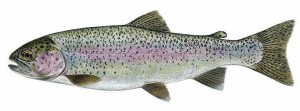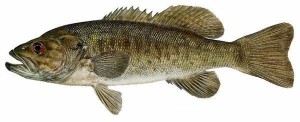Freshwater Fish in Maine Lakes, Ponds, Rivers and Streams
Out and About for the Sebago Lakes Region of Maine Feb. 12-18
February 11, 2015Little Ossipee Lake, Waterboro, and Moose Pond, Bridgton: Trophy Fishing in Maine Lakes
February 15, 2015Freshwater Fish in Maine Lakes, Ponds, Rivers and Streams
Ah, A Summer Day on Brandy Pond, Naples, Maine
Fishing is a favorite pastime of many Maine lakefront property owners.

Rainbow Trout, Oncorhynchus mykiss, to 44 inches
Introduced near the end of the 19th century as game fish.
The coloration of rainbow trout is variable–the dorsal surface ranges from greenish yellow to blue-gray with silvery colored sides. The belly is white to pale yellow. A large number of small black spots cover the upper body, with spotting heavier along the dorsal area and fins. A vague pink to prominent red band extends from the fish’s cheek to the base of the caudal fin. Rainbow trout favor clear, cold water. They prefer to stay deep and feed mainly on bugs.

Brook Trout, Salvelinus fontinalis, to 28 inches
Only native trout in eastern US; Maine home to most significant number in northeastern US; 1 1/2 year olds or fall yearlings are stocked as legal-sized fish.
Though the coloration is variable, brook trout tend to have a brownish-green back with dark, wavy, worm-like marks. On their sides are small reddish spots that are surrounded by blue halos. Their squarish tail and lower fins have white edges. Brook trout serve as indicators of the health of the watersheds they inhabit as they thrive in clear, cold water.

Brown Trout, Salmo trutto, to 40 inches
Introduced; brought over from Europe to Branch Lake in Ellsworth, circa 1885.
Brown trout are light brown or tawny with pronounced red and black spots on their bodies, from head to tail. The black spots are often surrounded by reddish halos. These fish survive by eating aquatic and terrestrial insects, but larger fish prey on sculpins, dace, crawfish and even their own fry. They most actively feed at night. Brown trout are maintained by an annual stocking program and thrive in all types of water.

Smallmouth Bass, Micropterus dolomieu, to 27 inches
Legally introduced as game fish in 1869; widely stocked statewide in 1880s.
A member of the sunfish family, smallmouth bass have three dark bars that extend as rays from their eyes. Vertical stripes on their bodies may come and go as they grow. The jaw joint of a smallmouth bass is located beneath the eye, unlike the largemouth bass, whose jaw joint extends beyond the eye. A notch between the spiny and soft-rayed section of the dorsal fin is not deep, further differentiating the smallmouth from the largemouth. The smallmouth bass’s diet consists of small invertebrates to fish and crayfish, becoming progressively larger as the bass grows.

Northern Pike, Esox lucius, to 54 inches
Introduced illegally; first documented in Great Pond in the Belgrade Lakes Region–an intentional illegal introduction in 1981, but may have originally been introduced into Little North Pond in 1969; Illegally stocked in southern and central Maine since 1985, including into the Songo River, which leads from Brandy Pond to Sebago Lake. The sides of a northern pike range from olive to dark green. The cheek and top half of the gill cover are scaled, while the lower half of the gill cover is unscaled. The red tinged fins have dark spots. The northern pike usually has four pairs of sensor pores on the lower jaw. A juvenile has wavy, white to yellow vertical bars, while an adult has shorter markings arranged in a more horizontal configuration. Some anglers describe them as aggressive, monster fish: They are basically all mouth.
photo credit: www.maine.gov
To learn more about lakefront properties for sale on Brandy Pond in Naples, Maine, click on the green box above.
To learn more about trophy fishing in Maine, click on the blog links below.
Lake Annabessacook in Monmouth and Winthrop, Maine: Home of Trophy Bass
Beech Hill Pond, Otis, Maine: Lakefront Property Owners Enjoy a Premier Fishing Lake

